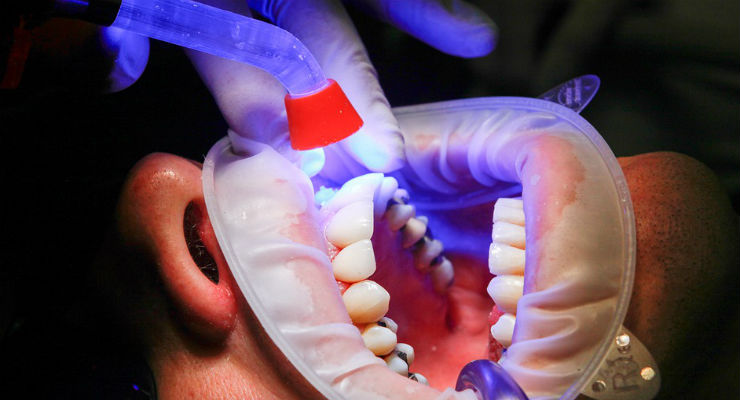Il batterio che lega la parodontite all’artrite reumatoide / The bacterium that binds periodontitis to rheumatoid arthritis
Il batterio che lega la parodontite all’artrite reumatoide / The bacterium that binds periodontitis to rheumatoid arthritis
Segnalato dal Dott. Giuseppe Cotellessa / Reported by Dr. Giuseppe Cotellessa

(Foto via Pixabay)
I ricercatori della John Hopkins University hanno scoperto un possibile legame fra paradontite e artrite reumatoide: un batterio, il cui meccanismo infettivo sarebbe alla base della risposta infiammatoria anomala tipica dell’artrite.
Parodontite e artrite reumatoide, due patologie diverse tra loro. O forse meno di quel che si crede. Uno studio condotto da ricercatori della John Hopkins University ha infatti portato alla luce nuove prove del legame fra queste due malattie. La ricerca, pubblicata su Science Translational Medicine, individua nel batterio Aggregatibacter actinomycetemcomitans, uno dei patogeni responsabili della grave forma di gengivite, come possibile fattore scatenante anche dell’artrite reumatoide (Ar).
In realtà non si tratta di una correlazione nuova, ma che risale addirittura agli inizi del secolo scorso. Infatti, alcuni pazienti che soffrono di artrite reumatoide sono anche affetti da parodontite, un’infiammazione cronica di natura batterica che colpisce i tessuti di sostegno dei denti. La frequente concomitanza delle due patologie ha portato a pensare che potesse essere proprio un batterioall’origine di entrambe e negli ultimi decenni la ricerca si è focalizzata su Porphyromonas gingivalis, senza però che se ne approfondisse il meccanismo infettivo.
I ricercatori della John Hopkins, guidati da Felipe Andrade, hanno invece spostato la loro attenzione su un altro patogeno, considerando un elemento fondamentale: a livello cellulare, il segno distintivo dell‘artrite reumatoide è la sovrapproduzione di proteine anomale, dette “citrullinate”. Il processo di citrullinazione, che prevede la sostituzione dell’arginina con un amminoacido atipico, la citrullina appunto, è in realtà un meccanismo che in situazioni normali la cellula utilizza per regolare la funzione delle proteine. Ma nell’artrite reumatoide questo sistema è fuori controllo: il corpo reagisce a questa ipercitrullinazione aumentando la produzione di anticorpi per combattere le proteine anomale, considerate alla stregua di nemici esterni e scatenando la risposta infiammatoria debilitante che caratterizza l’artrite. Lo stesso fenomeno è stato osservato anche nei pazienti affetti da parodontite. E l’infezione di A. actinomycetemcomitans sembra essere la responsabile del processo di citrullinazione.
Partendo da queste considerazioni, i ricercatori hanno sottoposto campioni di siero prelevati da192 pazienti affetti da artrite a test per verificare la presenza di anticorpi contro Aggregatibacter actinomycetemcomitans, scoprendo che quasi la metà riportava segni dell’infezione. Ma metà no. “Questo potrebbe indicare che altri batteri, della gola, dei polmoni o di altre aree del corpo, utilizzino un meccanismo simile per indurre l’ipercitrullinazione” spiega Andrade.
Pur trattandosi di conclusioni preliminari, che avranno bisogno di essere approfondite con altre ricerche, il lavoro di Andrade e colleghi apre la strada a un possibile trattamento antibiotico. I passi da fare per lo studio di questa malattia sono ancora molti, ma i ricercatori sono ottimisti: “Questa ricerca potrebbe essere la più vicina alla scoperta delle radici dell’artrite reumatoide” conclude il primo autore del lavoro, Maximiliam Konig.
ENGLISH
Periodontitis and rheumatoid arthritis, two different diseases. Or maybe less than what is believed. A study conducted by researchers at John Hopkins University has indeed brought to light new evidence of the link between these two diseases. The research, published in Science Translational Medicine, identifies in the bacterium Aggregatibacter actinomycetemcomitans, one of the pathogens responsible for the severe form of gingivitis, as a possible triggering factor of rheumatoid arthritis (Ar).
In reality it is not a new correlation, but that dates back to the beginning of the last century. In fact, some patients suffering from rheumatoid arthritis are also suffering from periodontitis, a chronic inflammation of a bacterial nature that affects the supporting tissues of the teeth. The frequent concomitance of the two pathologies has led to the idea that it could have been a bacterium at the origin of both and in the last decades research has focused on Porphyromonas gingivalis, without however deepening its infectious mechanism.
The John Hopkins researchers, led by Felipe Andrade, have instead turned their attention to another pathogen, considering a fundamental element: at the cellular level, the hallmark of rheumatoid arthritis is the overproduction of anomalous proteins, called "citrullinate". The citrullination process, which involves the replacement of arginine with an atypical amino acid, citrulline, in fact, is a mechanism that in normal situations the cell uses to regulate the function of proteins. But in rheumatoid arthritis this system is out of control: the body reacts to this hypercellullination by increasing the production of antibodies to combat the abnormal proteins, considered as external enemies and triggering the debilitating inflammatory response that characterizes arthritis. The same phenomenon has also been observed in patients with periodontitis. And A. actinomycetemcomitans infection appears to be responsible for the citrullination process.
Starting from these considerations, the researchers submitted serum samples taken from 180 patients with arthritis to test for the presence of antibodies against Aggregatibacter actinomycetemcomitans, finding that almost half reported signs of infection. But half no. "This could indicate that other bacteria, throat, lungs, or other areas of the body, use a similar mechanism to induce hyperclothing," explains Andrade.
Although these are preliminary conclusions, which will need to be investigated further, the work of Andrade and colleagues paves the way for a possible antibiotic treatment. The steps to be taken to study this disease are still many, but the researchers are optimistic: "This research could be the closest to the discovery of the roots of rheumatoid arthritis" concludes the first author of the work, Maximiliam Konig.
Da:



Commenti
Posta un commento